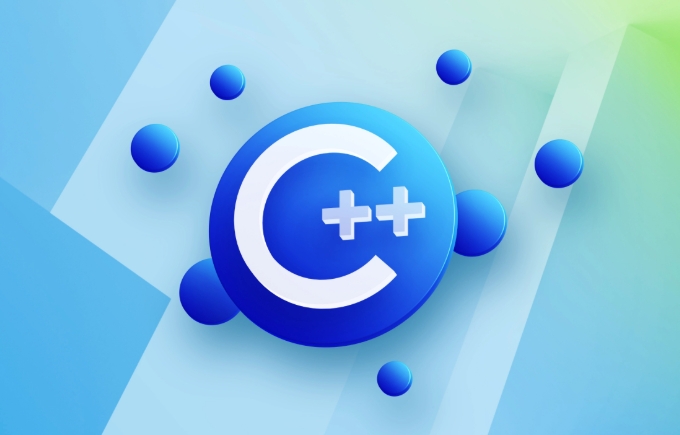To create a DLL or static library, you need to select a template first and then export the function. Steps: 1. Select the Static Library (.lib) template to create a project, add the .cpp/.h file, and compile and generate .lib; 2. Select Dynamic-Link Library (DLL) for DLL, use __declspec (dllexport) to export the function or .def file definition, and generate .dll and .lib; 3. When using it, copy the .lib and header files to the new project, and the configuration includes path and link dependencies. DLL also needs to place .dll in the same directory or system path as the executable file.

If you're working with C and want to organize your code into reusable modules, creating a DLL (Dynamic Link Library) or a static library is the way to go. Both have their use cases — static libraries get linked directly into your executable, while DLLs are loaded at runtime and can be shared across multiple programs. Let's walk through how to create both using Visual Studio, since that's one of the most common environments for Windows-based C development.

Setting up a Static Library Project
To start building a static library (.lib file), you'll need to set up a new project in Visual Studio:

- Open Visual Studio
- Choose Create a new project
- Select Static Library (.lib) under the C templates
- Name your project and click Create
Once the project is created, you'll see some boilerplate files. You can add your own .cpp and .h files just like in a regular application. The key difference is that instead of producing an .exe , this project will compile into a .lib .
Important:
Make sure all functions or classes you want to expose are defined in header files and implemented in .cpp files. Since it's a static library, everything gets compiled into the lib, and users of the library will include your headers and link against the .lib during their build.

You don't need any special syntax unless you're dealing with templates or inline functions that must reside in headers.
Creating a DLL Project
A DLL works a bit differently because it's meant to be used at runtime by one or more applications. Here's how to create one:
- Open Visual Studio
- Choose Create a new project
- This time select Dynamic-Link Library (DLL) from the templates
- Name and create the project
Visual Studio gives you a sample dllmain.cpp which handles entry points but usually doesn't require changes. You'll also get a .def file or a header where you can define exports.
Exporting Functions
To make functions accessible outside the DLL, you need to decorate them with __declspec(dllexport) when building the DLL, and __declspec(dllimport) when using it in another project. A common trick is to use a preprocessor macro:
#ifdef MYLIB_EXPORTS
#define API __declspec(dllexport)
#else
#define API __declspec(dllimport)
#endifThen prefix your functions like this:
extern "C" API int AddNumbers(int a, int b);
Using extern "C" prevents name mangling and makes the function easier to call from other languages ??or tools.
You can also export functions via a .def file if you prefer not to modify the source code, but that's less common these days.
Using Your Library in Another Project
Once you've built either a DLL or a static library, you'll want to use it somewhere else. Here's what you need to do:
For both types:
- Copy the
.libfile (or.dll.libfor DLLs) to your new project directory - Copy the public header files as well
In Visual Studio:
- Right-click your project → Properties → VC Directories → Include directories: add the path to your headers
- In Linker → Input → Additional Dependencies: add your
.libfilename - If it's a DLL, place the
.dllnext to your executable (or in a system path)
That's basically it. Once everything is wired up correctly, you can call functions from your library as if they were part of your own codebase.
Creating a DLL or static library in C isn't too hard once you know how Visual Studio structures things. It's easy to mess up include paths, export declarations, or forget to copy the DLL, so double-check those parts. Other than that, it's mostly just writing normal C code and organizing it properly.
The above is the detailed content of C tutorial for creating a DLL or static library. For more information, please follow other related articles on the PHP Chinese website!

Hot AI Tools

Undress AI Tool
Undress images for free

Undresser.AI Undress
AI-powered app for creating realistic nude photos

AI Clothes Remover
Online AI tool for removing clothes from photos.

Clothoff.io
AI clothes remover

Video Face Swap
Swap faces in any video effortlessly with our completely free AI face swap tool!

Hot Article

Hot Tools

Notepad++7.3.1
Easy-to-use and free code editor

SublimeText3 Chinese version
Chinese version, very easy to use

Zend Studio 13.0.1
Powerful PHP integrated development environment

Dreamweaver CS6
Visual web development tools

SublimeText3 Mac version
God-level code editing software (SublimeText3)

Hot Topics
 C tutorial on the Standard Template Library (STL)
Jul 02, 2025 am 01:26 AM
C tutorial on the Standard Template Library (STL)
Jul 02, 2025 am 01:26 AM
STL (Standard Template Library) is an important part of the C standard library, including three core components: container, iterator and algorithm. 1. Containers such as vector, map, and set are used to store data; 2. Iterators are used to access container elements; 3. Algorithms such as sort and find are used to operate data. When selecting a container, vector is suitable for dynamic arrays, list is suitable for frequent insertion and deletion, deque supports double-ended quick operation, map/unordered_map is used for key-value pair search, and set/unordered_set is used for deduplication. When using the algorithm, the header file should be included, and iterators and lambda expressions should be combined. Be careful to avoid failure iterators, update iterators when deleting, and not modify m
 How to use cin and cout for input/output in C ?
Jul 02, 2025 am 01:10 AM
How to use cin and cout for input/output in C ?
Jul 02, 2025 am 01:10 AM
In C, cin and cout are used for console input and output. 1. Use cout to read the input, pay attention to type matching problems, and stop encountering spaces; 3. Use getline(cin, str) when reading strings containing spaces; 4. When using cin and getline, you need to clean the remaining characters in the buffer; 5. When entering incorrectly, you need to call cin.clear() and cin.ignore() to deal with exception status. Master these key points and write stable console programs.
 C tutorial for graphics programming with OpenGL
Jul 02, 2025 am 12:07 AM
C tutorial for graphics programming with OpenGL
Jul 02, 2025 am 12:07 AM
As a beginner graphical programming for C programmers, OpenGL is a good choice. First, you need to build a development environment, use GLFW or SDL to create a window, load the function pointer with GLEW or glad, and correctly set the context version such as 3.3. Secondly, understand OpenGL's state machine model and master the core drawing process: create and compile shaders, link programs, upload vertex data (VBO), configure attribute pointers (VAO) and call drawing functions. In addition, you must be familiar with debugging techniques, check the shader compilation and program link status, enable the vertex attribute array, set the screen clear color, etc. Recommended learning resources include LearnOpenGL, OpenGLRedBook and YouTube tutorial series. Master the above
 C tutorial for competitive programming
Jul 02, 2025 am 12:54 AM
C tutorial for competitive programming
Jul 02, 2025 am 12:54 AM
Learn C You should start from the following points when playing games: 1. Proficient in basic grammar but do not need to go deep into it, master the basic contents of variable definition, looping, condition judgment, functions, etc.; 2. Focus on mastering the use of STL containers such as vector, map, set, queue, and stack; 3. Learn fast input and output techniques, such as closing synchronous streams or using scanf and printf; 4. Use templates and macros to simplify code writing and improve efficiency; 5. Familiar with common details such as boundary conditions and initialization errors.
 Using std::chrono in C
Jul 15, 2025 am 01:30 AM
Using std::chrono in C
Jul 15, 2025 am 01:30 AM
std::chrono is used in C to process time, including obtaining the current time, measuring execution time, operation time point and duration, and formatting analysis time. 1. Use std::chrono::system_clock::now() to obtain the current time, which can be converted into a readable string, but the system clock may not be monotonous; 2. Use std::chrono::steady_clock to measure the execution time to ensure monotony, and convert it into milliseconds, seconds and other units through duration_cast; 3. Time point (time_point) and duration (duration) can be interoperable, but attention should be paid to unit compatibility and clock epoch (epoch)
 What is the volatile keyword in C ?
Jul 04, 2025 am 01:09 AM
What is the volatile keyword in C ?
Jul 04, 2025 am 01:09 AM
volatile tells the compiler that the value of the variable may change at any time, preventing the compiler from optimizing access. 1. Used for hardware registers, signal handlers, or shared variables between threads (but modern C recommends std::atomic). 2. Each access is directly read and write memory instead of cached to registers. 3. It does not provide atomicity or thread safety, and only ensures that the compiler does not optimize read and write. 4. Constantly, the two are sometimes used in combination to represent read-only but externally modifyable variables. 5. It cannot replace mutexes or atomic operations, and excessive use will affect performance.
 How to get a stack trace in C ?
Jul 07, 2025 am 01:41 AM
How to get a stack trace in C ?
Jul 07, 2025 am 01:41 AM
There are mainly the following methods to obtain stack traces in C: 1. Use backtrace and backtrace_symbols functions on Linux platform. By including obtaining the call stack and printing symbol information, the -rdynamic parameter needs to be added when compiling; 2. Use CaptureStackBackTrace function on Windows platform, and you need to link DbgHelp.lib and rely on PDB file to parse the function name; 3. Use third-party libraries such as GoogleBreakpad or Boost.Stacktrace to cross-platform and simplify stack capture operations; 4. In exception handling, combine the above methods to automatically output stack information in catch blocks
 How to start learning C in 2024?
Jul 02, 2025 am 01:17 AM
How to start learning C in 2024?
Jul 02, 2025 am 01:17 AM
The key to learning C lies in the methods and rhythm. Learning C in 2024 has rich resources and tools to support. 1. Prepare the development environment: It is recommended to use tools such as VisualStudio, CLion or Xcode, or try online compilers to practice; there is no need to worry about advanced functions in the early stage, just complete "HelloWorld" first. 2. The learning content starts with basic grammar, gradually penetrates into core content such as pointers, quotations, memory management, etc., recommends "C Primer" and B station courses, and emphasizes the importance of hands-on practice. 3. Practice your hands through small projects such as calculators, grade management systems, and simple games to improve your understanding of program structure and develop good coding habits. 4. Pay attention to the particularity of C to avoid memory leakage,






